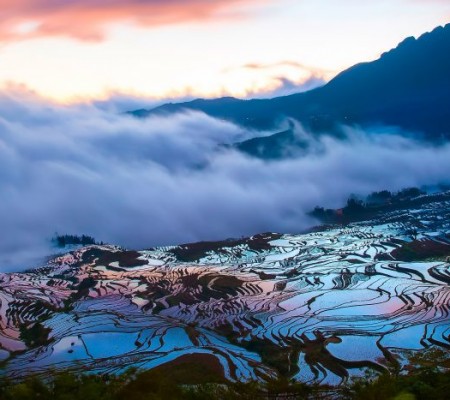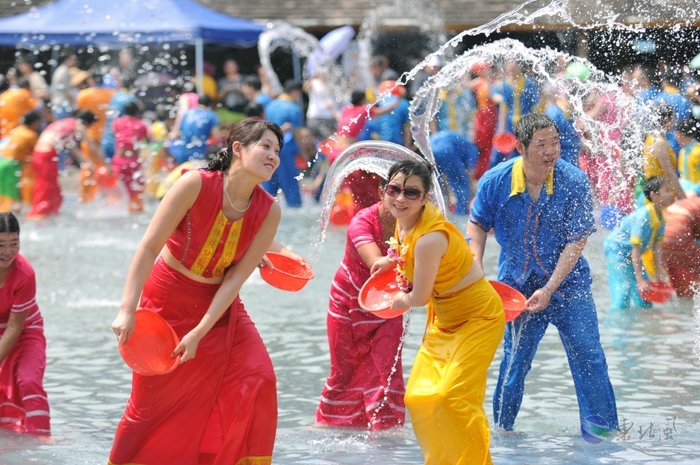
Dai Ethnic Minority
Dai is one of 55 ethnic minorities officially listed in China. They live mainly in southwest China and have their own unique customs and language. Dai minority regards peacock and elephant as mascot, folk story of Dai is rich and colorful. Dai people like to live by water, love cleanly, bathe frequently, women love to wash hair, so Dai is known as “ethnic minority of water”. In the past, Dai people generally believed in southern Buddhism and primitive religions.
Distribution of Dai Ethnic Minority
Dai ethnic minority is distributed in China, India, Vietnam, Cambodia and other countries. They live mainly in Xishuangbanna Dai Autonomous Prefecture, Dehong Dai and Jingpo Autonomous Prefecture, as well as Gengma County and Menglian County in Yunnan province. The rest are scattered in more than 30 counties like Jingdong, Jinggu, Lancang, Xinping, Yuanjiang and Jinping.
Dai Ethnic Towns
Yongxing Dai Ethnic Town Gaoda Dai and Yi Ethnic Town Wandian Dai Ethnic Town Mangkuan Yi and Dai Ethnic Town Longtan Yi and Dai Ethnic Town Mengjiao Dai, Yi and Lahu Ethnic Town Lishu Yi and Dai Ethnic Town Pingcun Yi and Dai Ethnic Town Dongpo Dai Ethnic Town Wanbi Lisu and Dai Ethnic Town Chuanfang Lisu and Dai Ethnic Town
Cultural Heritages of Dai Ethnic Minority
Dai Medicine Zhaoshutun and Nanmunuona- Narrative Poem Elephant-foot Drum Making Craft Pattra-leaf Scriptures Making Craft Brocade of Dai Ethnic Minority Rituals of Life Cycle Traditional Pottery-making Craft White Elephant Dance and Deer Dance Elephant-foot Drum Dance Pineapple Rice
Inheritors
Bo Hanbing Gen Dequan Yu Xiangla Yu La Yu Meng Ma Hazhuang Ye Juan Kang Langnuo Wang Yuanzhou Yang Yongfu Dao Ganxiang Han Gan Yang Guizhen Luo Meiying Yin Nong Yu Nannan Yu Nan’en Yanwen Hanzai Yu Ershuai Mi Me Ruan Shilin Bo Konglun Bo Yinghan Yi Xiang Yu Latao Jin Bao Sai Bing Zhan Mie Nan Guangcai Bo Wangdi Qian Wenming Dao Dewen Yu Guang Song Zirong Mie Yezhang Mi Zaijun Feng Qinyin Nan Zineng Feng Zhonggui Feng Jijin Jing Jigui Xiang Hen Gong Si Beng Deliang Xianbo Hanliang Jin Jiwen Yin Mingzhen Dao Yongguang Dao La’ai Bi Ya Shao Meihan Yan Handian Bo Nanduan Dao Shuming Wan Xiaosan Yan Wenyan Feng Chuanshi Kang Langtun Yejuan Yu Mengga Jin Xingming Dao Baoshun Wang La Yue Xiang Si Huazhang
Festivals and Activities of Dai Ethnic Minority
Bag-throwing Festival For Three Countries Sand Pile Activity of Mengwo Temple Water Splashing Festival in Menglian Siyueba (April 8th) Festival/Water Splashing Festival Woba Festival Shengmian Festival Water Splashing Festival in Yuanyang Loy Krathong Festival Water Splashing Festival in Jinghong Water Splashing Festival in Menghai Ganbai Festival Water Splashing Festival in Mengla Caihua Festival or Flowers Picking Festival Xuntianba Festival Songlong (Dragon Worship) Festival Huajie (Flower Street) Festival Guanmen (Closing Door) Festival Chuwa Festival and Ganduo Festival Water Splashing Festival in Dehong Water Splashing Festival in Xishuangbanna Water Splashing Festival in Jinping Men’s Day of Dai Ethnic Minorities Flower-collecting and Water Splashing Festival Holy Fish Festival Water Splashing Festival of Dai Ethnic Minority Kaimen (Opening Door) Festival
Keep Reading
Ruili City- Hometown of Peacock Dance Dabinglangyuan Village Dai (Huayao Dai) Ethnic Culture Protection Area in Gasa Town of Xinping County, Yuxi Manting Dai Ethnic Culture Protection Area in Menghan Town, Jinghong City Dadenghan Village Dai Ethnic Culture Protection Area in Ruili City, Dehong Stupa, Temple and Young Buddhist Monks of Dai Ethnic Minority Carpet-Wrapping Courting and Threading-Tying Marriage of Dai Ethnic Minority Fragrant Couch-Grass Barbecue and Fragrant Bamboo Rice by Dai Ethnic Minority Bamboo Houses in Green Trees of Dai Ethnic Minority The Clean and Nice-looking Wells of Dai Ethnic Minority Interesting Placenames of Dai Ethnic Minority Dai Ethnic Minority: A water-loving Minority

 7 Days GolfingTour
7 Days GolfingTour
 8 Days Group Tour
8 Days Group Tour
 8 Days Yunnan Tour
8 Days Yunnan Tour
 7 Days Shangri La Hiking
7 Days Shangri La Hiking
 11 Days Yunnan Tour
11 Days Yunnan Tour
 6 Days Yuanyang Terraces
6 Days Yuanyang Terraces
 11 Days Yunnan Tour
11 Days Yunnan Tour
 8 Days South Yunnan
8 Days South Yunnan
 7 Days Tea Tour
7 Days Tea Tour
 8 Days Muslim Tour
8 Days Muslim Tour
 12 Days Self-Driving
12 Days Self-Driving
 4 Days Haba Climbing
4 Days Haba Climbing
 Tiger Leaping Gorge
Tiger Leaping Gorge
 Stone Forest
Stone Forest
 Yunnan-Tibet
Yunnan-Tibet
 Hani Rice Terraces
Hani Rice Terraces
 Kunming
Kunming
 Lijiang
Lijiang
 Shangri-la
Shangri-la
 Dali
Dali
 XishuangBanna
XishuangBanna
 Honghe
Honghe
 Kunming
Kunming
 Lijiang
Lijiang
 Shangri-la
Shangri-la
 Yuanyang Rice Terraces
Yuanyang Rice Terraces
 Nujiang
Nujiang
 XishuangBanna
XishuangBanna
 Spring City Golf
Spring City Golf
 Snow Mountain Golf
Snow Mountain Golf
 Stone Mountain Golf
Stone Mountain Golf












